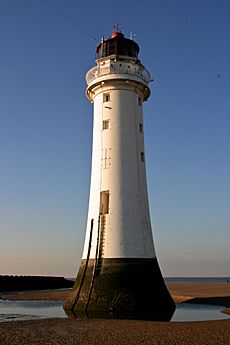New Brighton Lighthouse facts for kids
| Location | Liverpool Bay New Brighton, Merseyside England |
|---|---|
| Coordinates | 53°26′40″N 3°02′32″W / 53.444334°N 3.042309°W |
| Year first constructed | 1683 (first) |
| Year first lit | 1830 (current) |
| Deactivated | 1973–2016 |
| Construction | Granite tower |
| Tower shape | Tapered cylindrical tower with balcony and lantern |
| Markings / pattern | White tower and red lantern |
| Height | 28.5 metres (94 ft) |
| Characteristic | Fl W(2) R(1) |
The New Brighton Lighthouse is a well-known landmark located where the River Mersey meets Liverpool Bay. It sits on a rocky area called Perch Rock, off the coast of New Brighton, Merseyside. This lighthouse is also known as Perch Rock Lighthouse. In the 1800s, people called it the Black Rock Lighthouse. It stands proudly next to Fort Perch Rock, which is a historic fort from the time of Napoleon.
Contents
The Lighthouse's Story
Early Beginnings: The First Beacon
The name "Perch Rock" comes from a very old wooden structure. This structure was like a tall tripod that held a lantern. It was first put up in 1683. Its job was to act as a simple light to help ships avoid the dangerous rocks.
Building the Current Lighthouse
As the Port of Liverpool grew bigger in the 1800s, the old wooden beacon was not enough. It needed too much care and did not give off enough light. So, a new, stronger lighthouse was needed.
The current lighthouse was designed by John Foster Jr. Building started in 1827. Workers used strong blocks of Anglesey granite. These blocks were fitted together like puzzle pieces, using special "dovetail joints" and marble pins. This building method was similar to how John Smeaton built the Eddystone Lighthouse many years before.
How the Lighthouse Looked and Worked
The lighthouse looks like the trunk of an oak tree. It is a tall, white tower with a red iron top where the light shines. It stands about 29 meters (95 feet) tall. The light first shone in 1830. It showed two white flashes, then one red flash, every minute.
The light came from thirty special lamps called Argand lamps. These lamps were on a three-sided spinning frame. One side had red glass in front of the lamps to make the red flash. Under the light, there were three bells. These bells rang as a fog signal, helping ships find their way in foggy weather. The same clockwork machine that spun the lights also rang the bells.
Life After Deactivation
The lighthouse was used continuously until October 1973. By then, new technology made it unnecessary for guiding ships. Even though its main job ended, the lighthouse is still in great shape. Its lights and fog bells were removed, but many other parts are still there.
In 2001, the lighthouse was cleaned and repainted. New LED lights were put in. These lights flashed the names of people who were lost at sea, including all 1,517 victims of the Titanic sinking.
Today, when the tide is low, you can walk to the base of the tower. However, you need a ladder about 25 feet tall to reach the entrance. The Kingham family privately owns and takes care of the lighthouse. It is a Grade II* listed building, which means it is a very important historic building.
Since 2015, the lantern has been lit again using LEDs and solar panels. This new light can only be seen from the land. It shows the same pattern as the old light: two white flashes followed by a red flash.
More to Explore
- List of lighthouses in England
- Grade II* listed buildings in Merseyside


